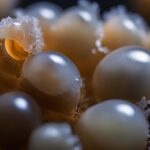7 Best Snails for Betta Tank best snails for betta tank
A betta is a large genus of small and colorful freshwater, ray-finned fishes in the gourami family. The most common member, Splendens, is known as the Siamese fighting fish – the species you often find in aquariums in people’s homes and home offices.
Betta can tolerate low oxygen, can survive in low-quality water due to their unique labyrinth organ, and are colorful. It is not uncommon to see them in tanks in people’s homes and home offices because they originated from small puddles of water and prefer to live there.

However, having only fish in an aquarium is not good enough. As a result, many people tend to introduce other creatures into their tanks. So, if you wish to combine bettas and snails, you will find this article fascinating because I have done it before.
So, I will show you the 7 best snails for your Betta tank, answer some frequently asked questions, and share other useful tips with you. Now, let’s get started!
Benefits of Having Snails in Betta Tanks
You see, I love snails and have always wanted to watch them grow in my home. Consequently, I bought snails and introduced them to my tank. Before taking that step, I researched and found that snails help to clean up the algae that usually builds on the glass tank and decorations.
If you don’t check algae growth in your betta tank, the tank will look disgusting. Likewise, snails are constant grazers, so they will eat live plants and dead plant matter in the tank, helping to keep it clean. Yes, I was elated when I realized that I could use snails to slow down algae growth in my aquarium.
Additionally, when you add snails to the aquarium, you enhance the aesthetics of the tank and your home. Think of it this way: snails have intriguing behavior, unique shell patterns, and peaceful nature, not to mention their multiple colors. That’s why they are fun to watch. Indeed, that’s another reason why you should combine them in one tank.
Plus, when snails contribute to the biological filtration process in water through waste removal, they improve the water quality for cohabitants. For instance, snails eliminate uneaten fish diet, decaying plant matter, and algae; these are some of their favorite snacks. Water quality improves once they get rid of all those.
7 Best Snails for Betta Tank
Because bettas eat snails, you need to be mindful of the snail specie you use for this. Therefore, I compiled the 7 best snails you should combine with a betta in a confined space to avert losses.
Mystery Snail (Pomacea bridgesii)
If you want snails that coexist with the fish in one tank, you should go for Mystery snails. I sure recommend it to all beginner aquarists. With 1.5 – 2 inches sizes, Mystery snails are good because their sizes are okay for the tanks.
They also feed on algae and detritus, thus helping to keep the tank clean. Another attribute that makes them a must-try is that they are peaceful, meaning that you don’t have to worry about your fish. Interestingly, they have lots of color variants, making your tank an attractive sight to behold. When they start moving, that will also spice up the ecosystem and you will have a great time watching them move around. On the flip side, they will snack on your live plants if they don’t have algae to feast on.
You need to feed them calcium-rich foods for their shell to keep them going. The species also needs a temperature of 24 to 30 degree Celsius and a water pH of 6.5 – 7.5. Still, if you have soft water, supplement it with calcium. Given the bi-load they produce, you should go for this if you have a 15-gallon aquarium.
Nerite Snail (Neritina natalensis)
Nerites survive well at 24 – 30 degrees Celsius. Yes, it is okay to introduce this snail species to your betta tank because they can live in harmony with their “landlords.” By eating algae and detritus, they keep the tank clean. Because they are pretty small, Nerites won’t occupy all the space.

In their natural habitat, Nerites are found in brackish waters or water of fresh and salt water. So, they can easily escape if they get the opportunity. I advise you to block all possible exits, especially the lid. Because these species don’t reproduce in freshwater, you don’t have to worry that they will overcrowd your aquarium. The downside is that you can see a cluster of their eggs everywhere. You also have to match the Betta and nerite personalities. Nonetheless, you can use a flat object to remove the eggs.
As for the appropriate water pH, keep it between 7.5 and 8.5 degree Celsius. Lastly, introduce one Nerite per 5-gallon tank for them to have enough algae to eat.
Assassin Snails (Anentome Helena)
Oftentimes, I encourage aquarists to introduce this snail to control an existing snail population in the aquarium. Sure, they are called Assassins for eating other snail species. Assassins love temperatures between 22 and 28 degree Celsius. Although they enjoy eating meat, they can also eat algae and detritus, meaning that they will help clean up your aquarium.
They have yellow and brown color that enhances the appearance of your aquarium. Once you have introduced Assassins to your aquarium, you don’t have to keep changing the water. The reason is that they are sensitive to changes in water parameters. In fact, you will shock them the moment you change the water.
If you combine Assassins with other snails, Assassins will eat them. Also, they grow to about 3 inches or more and have a lifespan of two years. For the capacity, introduce 1 or 2 Assassins per 5-gallon tank.
Rabbit Snail (tylomelania zemis)
Aside from living well under 24 – 30 degree Celsius, Rabbits (or also known as Elephants) have a lifespan of 2 to 3 years. They are beautiful, and you can easily recognize them. Hence, many people keep them as pets. Much as they are not common, they are still widely available.
They are quite big and can grow more than 2 inches in length. Given this size, I recommend you go for a 5-gallon tank or even bigger. For them to enjoy your aquarium, ensure the water pH is between 7.2 and 7.8. Did I mention that they are scavengers?
Apologies! Yes, they are and will gladly eat anything to stay alive. So, you can rely on them to eat algae and dead plant matter. Caution: Rabbits can constitute a nuisance in your aquarium or become a threat to your Bettas. Nonetheless, they are not known to kill or eat up the fish.
Japanese Trapdoor Snail (cipangopaludina japonica)
Over time, the Japanese Trapdoors became popular due to their color and shape. They have an operculum that protects them during attacks. They guard themselves against harm by sealing themselves inside when they are resting or when the water condition is not good. Well, their ideal water pH is 6.5 to 8. For the color variants, they come in white, green, gold, dark brown, etc.
Japanese Trapdoors measure about 1 to 2 inches in size, have a long lifespan of 5 – 10 years, and survive under 20 and 30 degree Celsius. They are easy to care for, relatively peaceful, and do well in tanks of 15-gallon capacity. On the other hand, you should ensure the tank has a lid because Japanese Trapdoor snails can wander off.
Plus, they don’t aerate the substrate. If you are not sure what to feed it, look for algae growth in the tank and add some pellets to it. You can be sure they will make your fish great buddy.
Pond Snail (lymnaea stagnalis)
Pond snails eat algae, dead plant matter, uneaten fish food, and just anything else. This means that you can always trust them to keep your aquarium clean. Ponds grow 1 to 2 inches in size and have a lifespan of 1 to 2 years.
They enjoy temperatures between 15 and 30 degree Celsius and love water with a pH level of 6.5 to 8.0. More often than not, people use them as pets, and they are good at burrowing and aerating the substrate. Plus, they are sensitive to water parameters, meaning that you don’t necessarily have to change your water all the time.
If you need snails that reproduce at the speed of light in your 3-gallon tank, you should opt for the Pond species. For their downsides, their population can get out of control, they eat smaller snails, and they are not so beautiful. However, you can always remove the eggs to control their explosive population growth.
Believe it when I say that they will make your fish ideal playmates.
Ramshorn Snail (planorbarius corneus)
It measures 0.25 to 1 inch and has a lifespan of 6 – 12 months. Before you introduce it to your aquarium, ensure its pH is between 6.5 and 8. They have multiple colors, including red, brown, and green; this makes your aquarium mind-blowing.
It eats algae, detritus, and dead plant matter to keep your tank clean and lays tiny eggs all over the place. As always, you can keep its population in check by cleaning your tank regularly. Even though they are not good at swimming, they may swim to the top of the tank to breathe in air. Because they are not great swimmers, they cannot survive in aquarium with a strong water current.
They can also overpopulate the tank. The ideal temperature for breeding them is 22 to 28 degree Celsius. For the capacity, introduce 3 to 6 Ramshorn snails per 5-gallon tank.
Frequently Asked Questions (FAQs)
These are my answers to these FAQs:
How do I choose the appropriate Betta tank for snails?
When deciding the right tank to use for your aquarium, you should consider the temperament of the Betta fish. The thing is that they don’t have similar attributes and personalities. For instance, the Siamese fighting fish commonly fight and kill other male Betta species with a slight resemblance but may ignore snails in the same tank. Therefore, you should note that space or territory means so much to that species.
Do Betta fish eat snails and vice versa?
Well, bettas are carnivores, meaning that your snails are also on their menu. However, they don’t eat the big species, such as Rabbits because they are too big to hassle. Also, Japanese Trapdoors can defend themselves from Betta fish. However, other species without operculum may not be able to defend themselves. To avert this, always feed your fish so they don’t go looking for snails to munch on. On the flip side, yes, snails can kill the bettas, but that’s very unlikely though. To be crystal clear, snails can only kill the fish if they have infected the fish with a disease they are not susceptible to. But then, this is rare, so you shouldn’t worry about it.
Can multiple snail species live in a betta tank?
Yes, you can add multiple snails to your aquarium. The reason is that they have different strengths and weaknesses. For example, some snails eat algae and dead plant matter better than others. By bringing them into that enclosed space, you end up creating a well-rounded team capable of keeping your aquarium clean and improving its aesthetics. I combined Assassins and Ramshorn to keep my snail population under control. Sure, it worked well. However, I had to keep watching them closely to be sure that things were going smoothly.
Final Thoughts
In this article, I fully explained the characteristics of the 7 best snails for Betta tanks to help you overcome the challenges several aquarists face. Earlier, I discussed the benefits of combing the two creatures in one tank, meaning that you won’t enjoy the benefits if you do not. Furthermore, you will find the list I compiled useful because not all snails consume algae, but you need those that eat up algae to help you keep your Betta tank clean.
Apart from the snail species I have reviewed in this article, there are other species that you may add to your Betta tank, such as Turret, Ivory, Apple, Pest, Malaysian Trumpet, etc. Since you have decided to add snails to your betta tank, don’t worry about it. All you have to do is watch the aquarium closely. Pair the Bettas with small-sized snails too. In conclusion, it is safe to say that you have learned so much. So, try it now and don’t forget to share your findings with me later.







